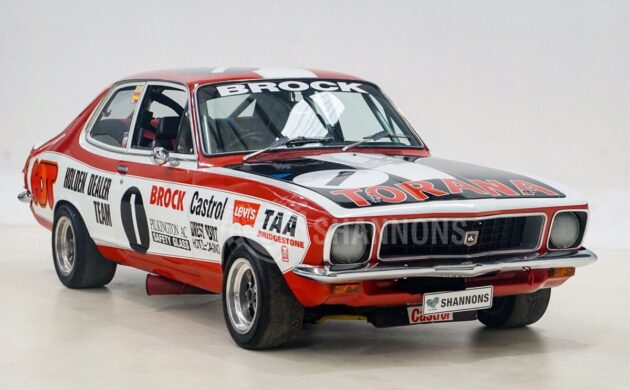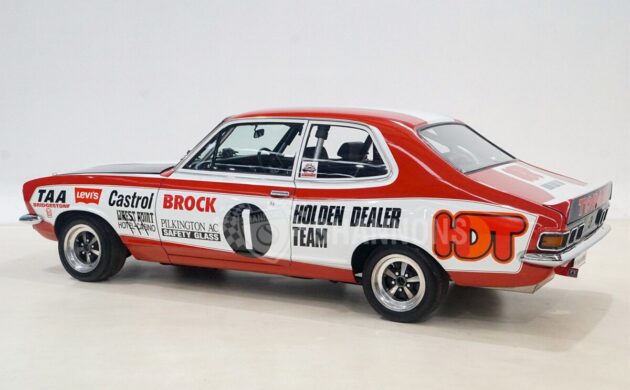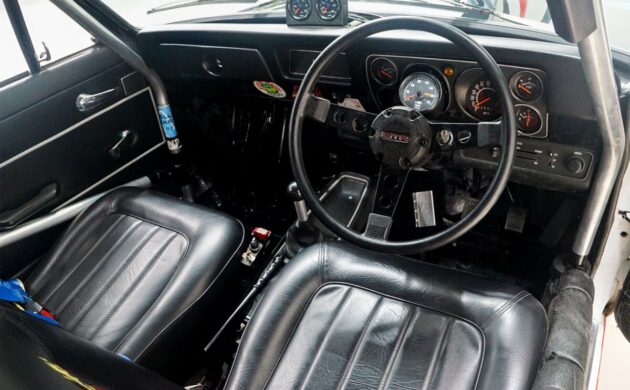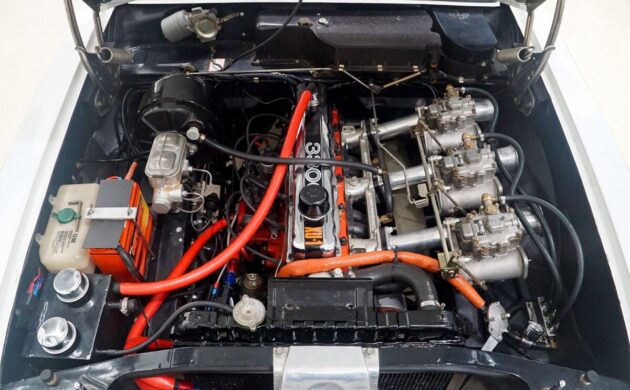While it is possible to draw some parallels, the Australian and American performance car scenes followed very different paths. Many American manufacturers based their high-performance models on Hardtop or Coupe variants. Lower sales volumes Down Under saw companies like Holden and Ford select sedans to produce iconic models such as the Falcon GTHO and Torana L34. One notable exception was the Torana XU-1. The Torana sedan (both the LC and LJ models) sold in significant numbers, but the sporting versions were based on the two-door variant. This 1973 LJ Torana XU-1 has a successful racing pedigree and was saved from the elements to be returned to its former glory. It is set to go over the auction blocks in an online auction in the first week of August. The Torana is located in Melbourne, Australia, and is listed for auction here at Shannons Auctioneers. The pre-sale estimate is between A$900,000 and A$1,200,000 (US$610,400 and US$813,900).
The LJ Torana, and this car, deserve some background before we dive into specifics. The first Torana, the HB model, rolled off the production line in May 1967. Based upon the humble Vauxhall Viva, its engine bay housed an 1,159cc four-cylinder engine producing 56hp. While it was a competent small car, its modest power output was not enough to excite the buying public. The company introduced its successor, the LC, in October of 1969. With a longer hood and extended wheelbase, buyers could order the new model with a six occupying its engine bay. Holden produced a performance two-door version called the GTR but upped the ante with its GTR XU-1. The XU-1 featured a 186ci version of Holden’s six-cylinder “red” motor. Equipped with a more aggressive camshaft, three Zenith-Stromberg CD-150 carburetors, cast-iron headers, and a performance cylinder head, the driver had 160hp at their disposal. February 1972 brought a mild facelift for the Torana, known as the LJ. The XU-1 continued as the performance offering, but its engine capacity grew to 202ci. The capacity increase and the change to triple CD-175 Zenith-Stromberg carburetors lifted engine power to 190hp. The LJ proved an effective weapon, with Peter Brock using the car to secure his first Bathurst win in a rain-effected race in 1972. Holden had plans for a V8 version for 1973, but an incident called “The Supercar Scare” saw Holden ax the V8 while Ford shelved its Falcon GTHO Phase IV. The motorsport governing body, CAMS, introduced updated racing regulations in 1973, allowing competitors to perform various upgrades to what were essentially showroom models for the Australian Touring Car Championship (ATCC) and the Bathurst 1000. The changes saw competitors and builders upgrade springs, shocks, wheels, and carburetors to make the most of these new regulations. This XU-1 is one of those cars and retains many of its original components. It has a long and illustrious racing history and is the car Peter Brock used to secure his first ATCC crown in 1974. However, it is the 1973 Bathurst 1000 for which it was best known. The XU-1 faced stiff opposition from the factory Falcon GTHO Phase III, a car producing nearly 350hp. While the XU-1 could top 130mph on Bathurst’s Conrod Straight, the GTHO could touch 160mph. The Torana’s lower weight made it more nimble across the twisting upper parts of the circuit, but the lack of outright pace saw it suffer on the climb up the mountain and down Conrod. The Holden Dealer Team’s (HDT) manager, Harry “The Fox” Firth, devised a plan to turn the race into an economy run, hoping to counter the Falcon’s speed advantage by having to make fewer pitstops. That is why I refer to this classic as both famous and infamous. It has always been the subject of debate, but many people believe that this strategy saw Holden snatch defeat from the jaws of victory. The team’s approach seemed to be working when Brock pitted to hand the car to his co-driver, Doug Chivas, for his stint behind the wheel. Chivas followed the plan, and part-way through his stint, the team held out a pit board reinforcing the need for economy. The plan backfired, with the car coughing on the top of the mountain as it ran out of fuel. Chivas successfully rolled down the mountain and Conrod Straight, but the Torana ran out of momentum short of the pitlane entrance. Racing regulations meant that the driver couldn’t receive any form of outside assistance, so Chivas was forced to jump from the car to push it into pit lane. Doug Chivas was a man of modest build, and after completing a stint behind the wheel, he was already pretty tired. It is one of the unforgettable images from that year’s race as he struggled to push the XU-1 uphill into the pits, being encouraged by his crew, who could not touch the car. He eventually succeeded, but the time lost destroyed their carefully devised plan. Brock climbed back behind the wheel and wrung the neck of the Torana for the rest of the day, finishing less than a lap behind the victorious Allan Moffat Falcon. It is true that Moffat had eased his pace once the Torana challenge faltered. Still, many people wonder what might have been had Brock been able to continue applying pressure to a Falcon that could be notoriously fragile if pushed to the limit.
Built by Harry Firth and Ian Tait for the 1973 racing season, changing regulations saw this car continue serving as the factory weapon into 1974. Brock took the car to victory in three of the first five rounds of the 1974 ATCC. He scored podiums in the other two rounds, giving it an excellent success rate. For the sixth round at Queensland’s Surfers Paradise International Raceway, Brock stepped into the team’s new SL/R 5000 model. The HDT handed this car to local driver Dick Johnson in a one-off appearance for the factory team. One of the lesser-known facts about this car is that it was once driven by a man whose name is now indelibly linked with the Ford brand in Australian motorsport. The car passed through the hands of several private competitors before being converted into a street car. Thankfully, its owners retained many of the original racing parts, including the CAMS Log Book that verifies its authenticity. The Torana disappeared from the radar for years before being discovered by an enthusiast parked on a residential front lawn in the early 1990s. It had occupied that spot for more than a decade! Once Ian Tait confirmed its identity, his son purchased the vehicle. He undertook a meticulous restoration process, with the car retaining more than 95% of its original parts. The panels were returned to their factory appearance, rust was eliminated, and the car wears a faultless recreation of its HDT racing livery. The paint shines beautifully, the signage and decals look perfect, and the car retains its original bobtail rear spoiler and subtle alloy spoiler hidden below the front valance. The wheels aren’t the factory items but are faithful replicas of the Globe Sprintmaster aluminum alloy wheels that graced the car during its heyday.
One of the quirks of Australian Touring Car regulations during the 1970s and early 1980s revolved around interior specifications. Because the vehicles were essentially modified road cars, competitors were forced to retain the interior trim and upholstery. That is why this car features black vinyl trim on the seats and doors, a headliner, and black carpet. CAMS allowed the fitment of additional gauges to monitor engine health, along with a rollcage for driver protection. This Torana’s interior presents as it would have in 1974, including a column-mounted tachometer and the extra gauges on top of the dash. One item that may cause modern racers to quiver is the rollcage. HDT built this car with an aluminum unit produced by a company called Bond Rollcages. It is not an integrated design, bolting to the floor and rear parcel tray in several locations. It did not extend beyond the car’s interior, offering no improvements in structural rigidity. The originality of this car extends to the rollcage, although the safety harnesses are a later addition.
Lifting this Torana’s hood reveals its 202ci six-cylinder engine. Its power feeds to the rear wheels via a four-speed manual transmission, while power front disc brakes help bring things to a safe halt. When it rolled off the line, this six would have produced 190hp. Racing regulations allowed upgrades to the camshaft, pistons, conrods, and carburetors. That last detail is fascinating because competitors could bolt on better carburetors, but they had to retain the original intake. That is why this XU-1 features a spacer to mount its Weber carburetors. The more observant will note that only one throat of each carburetor is functional, with the second one blocked for racing. This was simply because Holden designed the original intake for the single throat Zenith-Stromberg carburetors, and this was the only way to adapt the more efficient Webers. It may not have been the most elegant solution, but it proved effective. When this Torana hit the track, the little six pumped out around 240hp. The vehicle is ready for immediate use, although it isn’t road registered. As well as the all-important CAMS Logbook, the seller includes significant documentation tracking the car’s history and restoration.
Cars like this 1973 Holden Torana XU-1 are part of what could currently be considered a perfect storm in the Australian performance car scene. Holden ended local manufacturing in 2017, and following a few years of disappointing sales, General Motors permanently retired the brand from the start of 2021. That saw the values of their performance models climb significantly. This XU-1 takes that desirability to a higher level. On September 8th, 2006, Peter Brock lost his life behind the wheel of a Daytona replica while competing in a tarmac rally in Western Australia. The man who had become known as “Peter Perfect” or “The King of the Mountain” was gone. The public outpouring of grief was unprecedented in Australian motorsport history. However, his former race cars have become incredibly desirable as collectors and enthusiasts fight to preserve the great man’s legacy. That’s why the auction estimate on this car is high and why I won’t be surprised if it exceeds the top mark before the hammer falls.








Fascinating write up, we’ll done Adam.
https://www.youtube.com/watch?v=xyBZ7NiS1_Q
This car?
I would bid, but I’m sure there’s a rich Aussie out there who’s gonna pound 4 or five cans of Foster’s and outbid me…..
Fosters not in the top 10 beers in oz. I had a 2014 Holden(Chevy SS). Parts scarcity and a po d wife made me sell it. Wife is gone but so is the car.
Greg, there’s one thing us Aussies don’t do, and that’s drink Fosters. Haven’t for years. It’s foreign muck!
Should sell well to a countryman.Single throat webers were also used in some formula Jr’s.
wow!
Australian Touring Cars were required to have certain production numbers to qualify for entry, thus usually based on sedans.
Ford Falcon and Chrysler Valiant also used two door models for entries in the “Great Race”, the Bathurst 500 (miles) or 1,000 (kilometres) race.
Unfortunately, it is now a shadow of its former self, with V8 supercars taking over. BORING!
The mighty 6 cylinder Holden that beat the legendary GTHO , old mate had a Bathurst LJ & we had the speedo needle all the way around to the zero , just managed to take a bend in the Ludlow State Forest that had a huge tree on a bend that’d claimed a number of lives over the years , it was a handful. Quirks were the offset steering column , seats didn’t recline & rear windows didn’t go down , awesome car. Many people mistake the stock carbs as SU but they weren’t , Strombergs that were similar to SU
they look like DCOEs and MUST be utilized by the nxt owner.
These are as much beloved Down Under as cortina ‘top side’.
Brilliant write up by Adam with a few facts that even this Aussie was unaware of. Presumably Adam is also one of us locals down under.
I faintly recall a fuel incident, this confirms it!
I was still a Bob Jane fan at the time.
That year was still in the era when a lot of different makes participated and the Bathurst race, as well as the Touring Car series, provided variety of action.
Why infamous? Ted Bundey, Manson, Bonny and Clyde were infamous. Is there evil intent in this car which the write-up has missed?